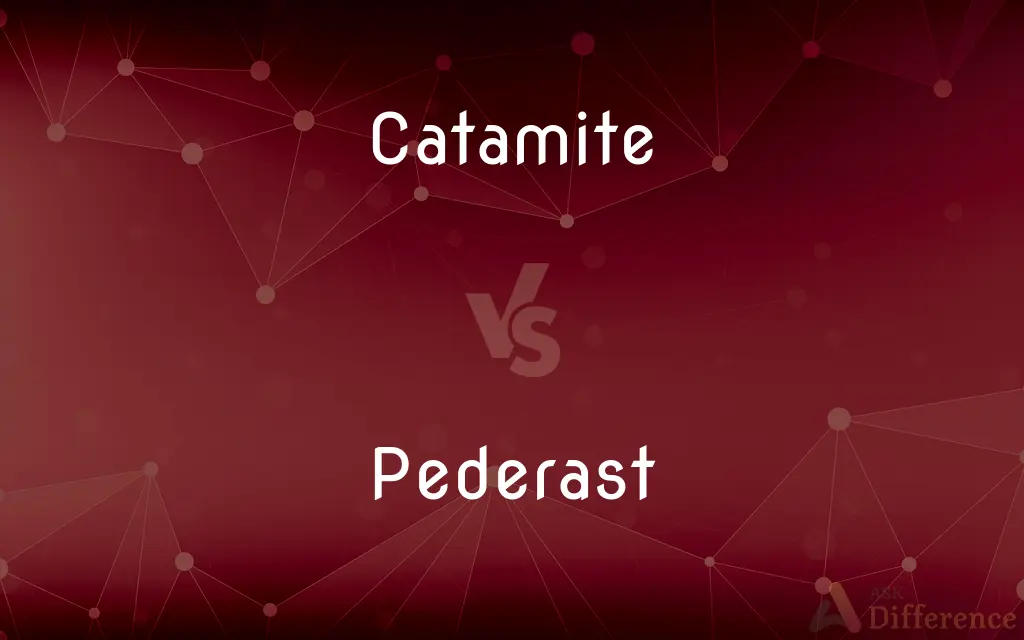Catamite vs. Pederast — What's the Difference?
Edited by Tayyaba Rehman — By Urooj Arif — Updated on March 27, 2024
A catamite is a boy in a sexual relationship with a man, often seen historically, whereas a pederast is an adult man who desires or engages in sexual relations with boys.

Difference Between Catamite and Pederast
Table of Contents
ADVERTISEMENT
Key Differences
A catamite, historically, refers specifically to a young boy who is involved in a sexual relationship with an adult man, a term that has roots in ancient practices and is now considered highly pejorative and outdated. On the other hand, a pederast is defined as the adult man in such relationships, highlighting the role distinction between the two terms within the context of these relationships.
The term catamite originates from the Latin word "catamitus," which itself is derived from "Ganymede," a figure in Roman mythology who was the beautiful young lover of Jupiter. This term carries significant historical and mythological connotations, emphasizing the passive role of the younger male in the relationship. Whereas pederasty, originating from the Greek "paiderastia," refers to the love of boys, focuses on the actions and desires of the adult male, showcasing the cultural and historical practices that accepted or tolerated such relationships, especially in ancient Greece.
In contemporary usage, both terms are considered offensive and are used in contexts that critically discuss historical, ethical, and legal perspectives on child abuse and exploitation. The use of "catamite" to refer to the boy in these relationships underscores the exploitative nature of these interactions, while "pederast" identifies and implicates the adult perpetrator.
The societal and legal implications of these terms have evolved significantly. Modern legal systems and societal norms condemn the practices described by both terms, viewing them through the lens of child protection and sexual abuse laws. This shift reflects a broader understanding of the power dynamics and the inherent exploitation involved in such relationships.
Both terms are fraught with historical baggage and are rarely used in contemporary discussions except in historical or critical analyses of ancient cultures or literature. The transition in language reflects a growing awareness of the importance of consent, the recognition of children's rights, and the criminalization of adult sexual interest in children.
ADVERTISEMENT
Comparison Chart
Definition
A boy in a sexual relationship with a man
An adult man who desires sexual relations with boys
Origin
Latin "catamitus," from Roman mythology
Greek "paiderastia," meaning love of boys
Historical Context
Often associated with ancient Rome
Associated with ancient Greek practices
Contemporary Usage
Considered offensive, used in historical/critical contexts
Also offensive, identifies the adult in such relationships
Legal/Societal Implications
Viewed as a victim of exploitation
Viewed as the perpetrator of abuse
Compare with Definitions
Catamite
Used in historical contexts to discuss ancient practices.
Scholars discuss the role of catamites in Roman society.
Pederast
An adult man who engages in sexual relations with boys.
The laws were designed to prosecute pederasts.
Catamite
Derived from mythological roots.
The word catamite reflects the story of Ganymede in mythology.
Pederast
Associated with historical and cultural practices, especially in Greece.
Pederasty was a documented aspect of ancient Greek society.
Catamite
A young boy involved in a sexual relationship with an adult man, historically.
In ancient texts, the term catamite is often used to describe young male companions.
Pederast
Subject to legal and societal condemnation.
Society and law now condemn the actions described by the term pederast.
Catamite
Considered derogatory in modern usage.
The term catamite is now rightly seen as pejorative.
Pederast
Critically analyzed in discussions of ethics and legality.
Modern analyses of pederasty critically examine its implications.
Catamite
Represents a victim in these contexts.
The catamite was often a victim of exploitation and abuse.
Pederast
Identified as the perpetrator in these relationships.
The pederast in historical contexts often held a position of power or influence.
Catamite
In ancient Greece and Rome, a catamite (Latin: catamitus) was a pubescent boy who was the intimate companion of a young man, usually in a pederastic relationship. It was generally a term of affection and literally means "Ganymede" in Latin, but it was also used as a term of insult when directed toward a grown man.
Pederast
A man who has sexual relations, especially anal intercourse, with a boy.
Catamite
A boy who has a sexual relationship with a man.
Pederast
A man who is engaged in an erotic relationship with an adolescent boy; a practitioner of pederasty.
Catamite
A boy or younger man in a homoerotic relationship with an older man.
Pederast
One guilty of pederasty; a sodomite.
Catamite
To engage in a homoerotic relationship involving a boy and an older man.
Pederast
A man who has sex (usually sodomy) with a boy as the passive partner
Catamite
A boy kept for unnatural purposes.
Common Curiosities
Are the terms catamite and pederast still used today?
These terms are considered offensive and are mainly used in historical or critical discussions of ancient practices and ethics.
What is a catamite?
A catamite historically refers to a young boy in a sexual relationship with an adult man, a term rooted in ancient practices and mythology.
How do modern societies view the practices described by catamite and pederast?
Modern societies condemn these practices, viewing them through the lens of child protection and sexual abuse laws.
What are the legal implications of being identified as a pederast?
Being identified as a pederast has serious legal implications, including criminal charges related to child sexual abuse and exploitation.
What are the consequences of these relationships in historical societies?
In historical societies, these relationships had various social and cultural implications, often tied to mentorship or social status, but are now reevaluated from a modern ethical standpoint.
Why are the terms catamite and pederast considered offensive?
These terms are offensive due to their historical association with exploitation and abuse of children, and their use underscores harmful power dynamics.
How do historical contexts influence the understanding of these terms?
Historical contexts, such as those in ancient Rome and Greece, provide insight into the cultural acceptance and practices related to these terms, though modern perspectives critically reassess these practices.
Is there a difference in the roles described by catamite and pederast?
Yes, the catamite refers to the young boy in such a relationship, while the pederast refers to the adult man, indicating their respective roles.
What does pederast mean?
A pederast is an adult man who desires or engages in sexual relations with boys, associated with cultural and historical contexts.
Can the term pederast apply to relationships with girls?
No, the term pederast specifically refers to adult men in sexual relationships with boys, not girls.
Share Your Discovery

Previous Comparison
Impune vs. Impute
Next Comparison
Gear vs. ClothesAuthor Spotlight
Written by
Urooj ArifUrooj is a skilled content writer at Ask Difference, known for her exceptional ability to simplify complex topics into engaging and informative content. With a passion for research and a flair for clear, concise writing, she consistently delivers articles that resonate with our diverse audience.
Edited by
Tayyaba RehmanTayyaba Rehman is a distinguished writer, currently serving as a primary contributor to askdifference.com. As a researcher in semantics and etymology, Tayyaba's passion for the complexity of languages and their distinctions has found a perfect home on the platform. Tayyaba delves into the intricacies of language, distinguishing between commonly confused words and phrases, thereby providing clarity for readers worldwide.















































